The words “full moon” in many languages

It is said that there are more than 6,000 languages worldwide (this is hard to imagine) and it is a fascinating concept to think, there are probably as many words for “full moon”.
Here we begin our little journey to the full moon. A few words about the fascinating quest of the greater purpose, that includes the full moon circulating through our lives. In layman’s terms and not always scientific (astronomy experts – don’t look too closely!). We would like to wish you illuminating moments. Enjoy!


It is said that there are more than 6,000 languages worldwide (this is hard to imagine) and it is a fascinating concept to think, there are probably as many words for “full moon”.
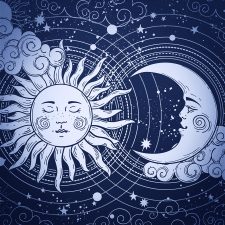
A full moon is when the Sun and the Moon are facing opposite, being in opposite direction from an Earth perspective.
This might feel astonishing if one imagines that the Moon is on one side, the Sun on the other and the Earth in between? Shouldn’t the Earth throw a shadow onto the Moon? Bingo – this is exactly what she does! But only when the Moon is exactly on the Earth orbit, the so called “ecliptic”. When this takes place, we speak of a lunar eclipse!

The Moon needs 27.33 days to circle around the Earth. Something that is also referred to as “sidereal time”. But because the Earth orbits the Sun, just like the Moon orbits the Earth, the Moon has to travel two further days in order to resume the same position to the Earth and Sun. This is then called the “sidereal time”. In order to determine the point of time of the reoccurring full moon, the sidereal time serves as basis.

We already know now that the moon month is mostly shorter than the calendar month, being on average approximately 29.5 days. If full moon falls on the first or second of a month, it is possible that another full moon occurs in the same month, for instance in July 2004:
Friday, 2 July 2004, 01:08:54 pm
Saturday, 31 July 2004, 08:05:06 pm
This event is also known as “blue moon”.

The answer is: “everywhere at the same time”. This refers to the so called Universal Time (UT) though, which is used for general astronomical events. We have already learnt that full moon is an astronomical event, where the moon, sun and the earth play a role by being in a specific position. So, full moon takes place at a specific time in the outer space. This point of time is specified by astronomers namely by the Universal Time.

There are multiple ways of approaching this question. If we look at it from a purely theoretical standpoint, we might be tempted to say that the full moon is infinitely short, since the phases of the moon are changing continuously. The moon is not yet quite full shortly before the full moon, and is already waning shortly afterwards.
However, there is a practical aspect that lets us quantify the full moon as a finite and measurable span of time: Since the Sun is significantly bigger than the Moon, its rays are able to reach just a little over half of the Moon’s surface. This means that the timespan in which the visible side of the Moon’s surface is irradiated (as seen from Earth) is longer than infinitely short.

Whether scientists, astrologers or esoterics, they agree on one thing: the moon influences earth and life on earth. For instance, it regulates the tides through its magnetism. Also continents feel the consequence of this magnetism and either raise or lower their position sometimes up to 26 cm.

In nature it is a known fact: for some animal species, mating takes place at full moon. However, the examples that can be found on this subject are rather simple. Full moon serves in some cases indirectly as the cause (for instance through the high water levels during the tides that the horseshoe crab uses to deposit its eggs) or also as the signal for both sexes of a species to begin at the exact same time to safeguard their future existence (a particular type of fly or also corals). It is understood that also wolves are led by full moon when it is time to mate.

… that people are looking for an argument at full moon or are especially happy …
… that if full moon is surrounded by a haze, a person dies …
… that you raise your hat three times to the moon (being a man) or you make a curtsey (being a woman), in order to protect yourself from misfortune until the next full moon …
… that whoever does not chink glasses with full moon at least once, does not deserve any happiness [Greek toast] …
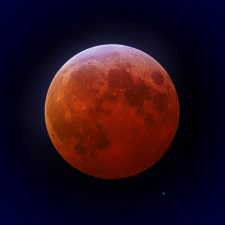
During a lunar eclipse, the Moon moves through the shadow of the Earth. Which means, that the Earth is positioned quite exactly between the Sun and Moon and casts its shadow onto the Moon. This is only possible at full moon and if some other requirements are met. Depending on whether the moon passes the partial or the core shadow of the Earth, we speak of a partial or total lunar eclipse.

Everyone knows that the sun is much larger than the moon and much further away from earth. In this very context lies a fascinating fact: both celestial bodies appear to be of similar size on the firmament, when observed from earth. Which implies that the sun has to be as many times bigger than the moon, as it is further away from the earth than the moon from the earth …

Who does not know the »moon boots« – these bulky snow boots, which appeared in the 70’s and 80’s and have taken their claim ever since in the winterly fashion scene. The Italian Giancarlo Zanatta designed the shoes, inspired by the moon landing in 1969. Astronauts Neil Armstrong and Buzz Aldrin wore overshoes with wide soles, which provided the formal inspiration for moon boots. Zanatta took immediate care of the production of the shoes with his company called Tecnica, which is run by his son Alberto Zanatta today, and still sells up to 700,000 pair per year.
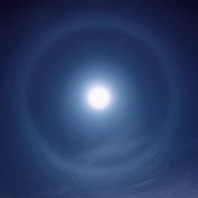
We would like to turn our attention to two interesting types of light apparitions around the Moon: halos and coronas. Both are optical phenomena in the atmosphere that, if looked at from a physical point of view, come about in different ways and also look dissimilar.
A halo (left picture) develops through refracting ice crystals and creates a clearly defined light ring around the Sun or the Moon, whereas the surface between the celestial body and the ring, almost appears to be empty. Light spots, light arches and pillars can also emerge.

Our article “Fishing during a full moon” has already indicated the discussion about whether moonlight might influence the behavior of fish. Now we have found a study, which was conducted by Australian scientists in 2013, who have examined the diving behavior of 39 gray reef sharks in Palau (an island country in the Pacific Ocean), namely with regards to environmental influences, like water temperature and also lunar happenings, in particular the full moon and the new moon. They tagged the sharks with transmitters and thus were able to measure where and how deep they dived during certain times.

Ansel Adams (1902–1984) was one of the most influential photographers in the US, who particularly became famous for his magnificent black and white photography of American landscapes and national parks. He is the role model of many photographers and set standards with his shots. And as chance would have it, one of his most renowned photographs is an image with the rising Moon in New Mexico.

The word “aggression” derives from the Latin verb “aggredi” which means »approach, attack«. This is interesting, because it does not only contain a destructive energy, but also a proceeding, solution-oriented energy. We also speak of tackling problems or approaching a task. During the course of the centuries, the component of attacking and destroying appears to have become dominant, so much so, that we judge aggression nowadays negatively and see the result to be destruction, violence and war. It is easily understandable now, why people are having such a difficult time to deal naturally with their aggressions that they express or restrain. We have put a negative mark on it. And we neither want to carry something negative inside us, nor do we want to voice it.
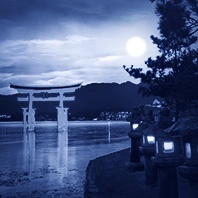
Japan has a custom, which is called “Tsukimi” or also “Otsukimi” that literally means “moon-viewing” (tsuki = jap. Moon). This tradition dates back to the Heian period (794–1192) where Japanese culture and the arts were refined to a high degree. At that time, elements of the Chinese “Mid-Autumn Moon Festival” were introduced in Japan, and festivals and rituals were held in the eighth sun month (which corresponds to September in our current calendar).

Lions mostly hunt in the dark, as predators have more of an advantage if it is as dark as possible. Hence, the moonlight is a disturbing factor, because it makes the predators easily detectable by their prey. And when the full moon is actually in the sky, it then so happens, that the lions occasionally come away empty-handed. Thus commences a time at full moon (and shortly before), where the lions begin to starve and hence their urge to hunt increases.

Almost exactly 40 years ago, on 06.02.1971, Alan B. Shepard succeeded the furthest one-handed golf swing in history to date, as commander of the Apollo 14 mission. He did not accomplish this due to any extraordinary abilities as a golf player, but because he struck the golf ball on the moon. And because of the prevailing, scarce amount of gravity and the absent braking effect in the atmosphere, the ball flew extremely far.
Shepard had to strike the ball one-handedly, as the rigid space suit did not allow two-handed play. He undertook four attempts and struck two balls altogether. How far exactly they flew has not been documented, however, one can assume a couple of hundred metres. In the original audio material of NASA, you can hear Shepard saying jokingly, after his last tee off »Miles and miles and miles …«.
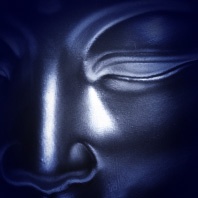
Today is full moon and for many Buddhists this is a special day, because the Vesak holiday is celebrated worldwide. According to tradition, Buddha was born on full moon in May, later became enlightened and also passed away on this day. This is how this day is honoured in countries like Singapore, Vietnam, Thailand, Indonesia and also in India, Nepal, Sri Lanka and many more. And above all of this, the full moon shines.